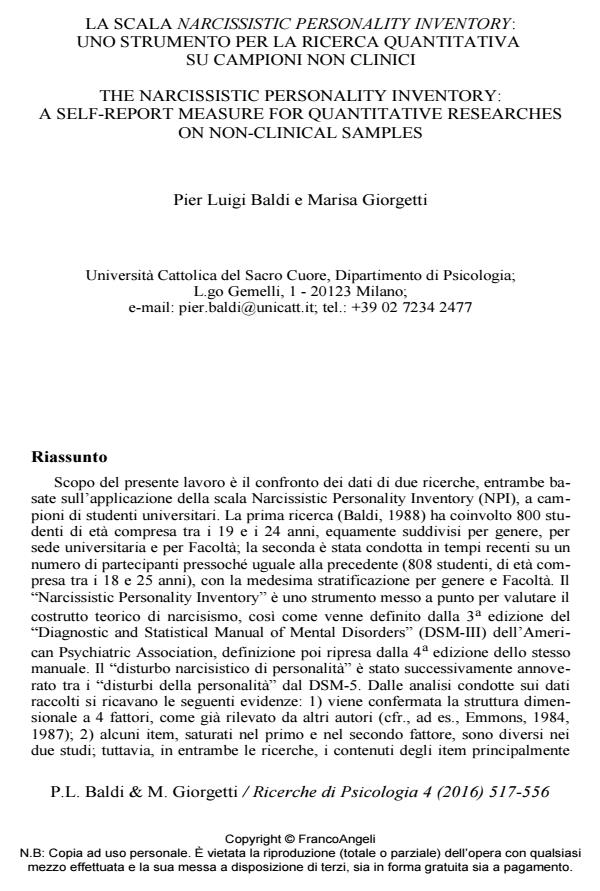The narcissistic personality inventory: a self-report measure for quantitative researches on non-clinical samples
Journal title RICERCHE DI PSICOLOGIA
Author/s Pier Luigi Baldi, Marisa Giorgetti
Publishing Year 2017 Issue 2016/4
Language Italian Pages 38 P. 517-554 File size 300 KB
DOI 10.3280/RIP2016-004004
DOI is like a bar code for intellectual property: to have more infomation
click here
Below, you can see the article first page
If you want to buy this article in PDF format, you can do it, following the instructions to buy download credits

FrancoAngeli is member of Publishers International Linking Association, Inc (PILA), a not-for-profit association which run the CrossRef service enabling links to and from online scholarly content.
The aim of this research was the comparison between the data of two studies, both based on the application of the Narcissistic Personality Inventory Scale (NPI) to samples of undergraduate students. The first sample (Baldi, 1998) consisted of 800 students, aged between 19 and 24, equally divided by gender, University and Faculty; the second one was recently conducted on a number of participants almost equal to the previous (808 students, aged between 18 and 25), with the same stratification by gender and Faculty. The Narcissistic Personality Inventory uses behavioural criteria as defined by American Psychiatric Association in the "Diagnostic and Statistical Manual of Mental Disorders" (3rd ed.) (DSM-II1) to evaluate narcissistic personality and also used by DSM-IV. The "narcissistic personality disorder" was later counted among the "personality disorders" by DSM-5. The data analysis show the following results: 1) a four-factor structure is confirmed, as previously reported by other authors (see, e.g., Emmons, 1984, 1987); 2) some items, which are saturated in the first or in the second factors are different in our two surveys: however in both of them the mostly saturated items in the first component (which accounts for the greatest percentage of variance), refer to exploitation and/or manipulation personality traits; 3) similar findings in relation to gender differences and Faculty are observed in our studies: males are more disposed to adopt narcissistic attitudes and behaviors; students of Law, both men and women, report higher scores of "narcissism" than students of Humanities, whose scores are lower than those of all the other Faculties.
Keywords: Personality, narcissism, measure, undergraduate students.
Pier Luigi Baldi, Marisa Giorgetti, La scala narcissistic personality inventory: uno strumento per la ricerca quantitativa su campioni non clinici in "RICERCHE DI PSICOLOGIA " 4/2016, pp 517-554, DOI: 10.3280/RIP2016-004004